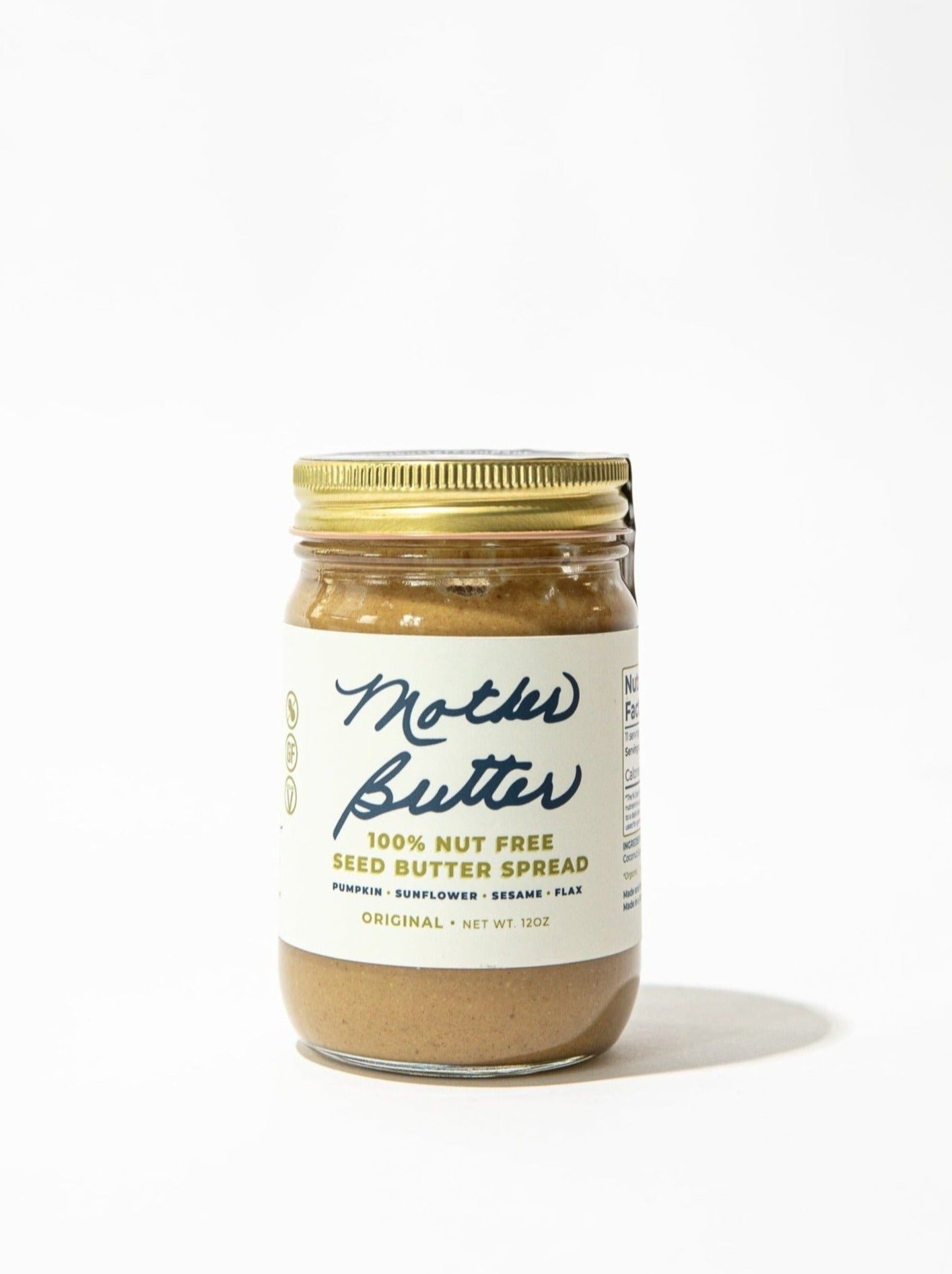
Our HEALTH blog posts focus on the dietary research we're inspired by, and what drives our belief in food as "proactive health". This article was contributed to Mother Butter by Nutrition Professional Lauren Kuda, MS.
Is fat our foe?: Everything you need to know about dietary fat!
When it comes to eating dietary fat, you may be met with skepticism and worry about the negative health effects it has long been associated with. Over the last several decades, fat has been demonized by the media, health and fitness enthusiasts, and even medical experts, all of whom agreed that fat was the primary cause of the growing obesity epidemic and rates of heart disease. Instead, a low-fat diet was touted as the best approach for optimal health. It wasn’t until recently that the claims about fat have been recognized as misconceptions. Not only is fat an essential macronutrient for our bodies, but eating more of it is also one of the most powerful ways to manage our hunger and weight, support our brain and hormone health, and increase our energy.
Before diving into why fat is necessary for optimal health, we need to understand that the different types of fat— and not all of them are equal!
Types of Fats
We’ve established that incorporating fat into our diet is critical for our health, but it’s also important to know which ones to choose. There are three main categories:
Unsaturated Fats: These fats have been shown to improve cholesterol levels, reduce inflammation, and are associated with a lower risk of developing heart disease. They’re liquid at room temperature and primarily found in vegetables, fish, nuts and seeds. They can be further broken down into two types: monounsaturated and polyunsaturated.
- Monounsaturated fats have one unsaturated chemical bond. Oils with these fats turn into a solid when refrigerated. Foods rich in monounsaturated fats include avocados, olive oil, and nuts such as almonds, hazelnuts, and macadamia nuts. These fats have been touted as the “healthiest” of them all because they help regulate blood cholesterol levels and have a positive impact on cardiovascular health.
- Polyunsaturated fats have more than one unsaturated chemical bond and are liquid whether at room temperature or refrigerated. They can be found in fish, flaxseeds, walnuts, and oils such as sunflower, safflower, and corn oil. There are two important types of polyunsaturated fats to be aware of: omega-3 fatty acids and omega-6 fatty acids. These fats are also known as essential fatty acids (EFAs) because unlike other fats, our bodies can’t synthesize them and they must be obtained from food.
- The three main omega-3 fatty acids are eicosapentaenoic acid (EPA), docosahexaenoic acid (DHA), and alpha-linolenic acid (ALA), all of which help support heart and brain health. EPA and DHA can be found in seafood, whereas ALA is found in plant sources like flax and chia seeds.
- The two most common omega-6 fatty acids are linoleic acid (LA) and arachidonic acid (ARA). Like omega-3s, they’re also crucial for brain function, cell growth, and heart health. They are primarily found in vegetable oils, as well as nuts, seeds, meat, and eggs.
Saturated Fats: Solid at room temperature, they are primarily found in meat and dairy, but also can be found in vegetable oils like coconut and palm oil. Saturated fat often gets vilified for being one of the leading causes of heart disease because it can raise LDL (“bad”) cholesterol. However, recent research is finally setting the record straight that there isn’t a link between saturated fat and heart disease. In fact, saturated fat is important for our health for several reasons. Not only can it increase HDL (“good”) cholesterol, but it’s also vital for energy, the absorption of fat-soluble nutrients, and healthy hormone function.
Trans Fats: Trans fats are the most harmful for our health because they can raise LDL cholesterol and lower HDL cholesterol, which in turn can increase heart disease risk. These fats can be found naturally in meat and dairy products in small amounts. However, most trans fats are created through a manufacturing process known as hydrogenation. Hydrogenation is used to convert vegetable oils into solids to extend the shelf life of products. The end result: partially hydrogenated oils, or PHOs. Before being banned by the FDA, PHOs were commonly found in processed food and snacks. Think: fried fast food, packaged baked goods, margarine, and vegetable shortening. While the goal is to make all food free of artificial trans fat, currently the FDA allows manufacturers to round down to 0 if a product contains 0.5g or less of trans fat per serving. This amount may seem small, but when more than one serving of these foods is consumed, it can add up! Checking food labels and ingredient lists for PHOs is the best way to see if a product contains trans fat.
Fat Facts
We’ve taken a closer look at the different types of fats and determined which ones to prioritize in our diets, but if you’re still not convinced that fat isn’t the enemy, here are just a few more reasons why fat is necessary for our health:
- Fats are required for the proper production and function of hormones, especially cholesterol. Our bodies use cholesterol as the starting point to make essential hormones like estrogen and testosterone. Without adequate fat in our diets, the balance of these essential hormones can be disrupted.
- Fats are a crucial part of nutrient absorption. Vitamins A, D, E, and K, are fat-soluble vitamins, which means that our bodies need dietary fat to absorb them from the digestive system. Foods with a higher fat content make fat-soluble nutrients more bioavailable. Without fat from the diet, these nutrients will not be properly absorbed.
- Fats are the building block of all the cells in our body. They make up the cell membrane that surrounds the outside and help control what can enter and leave each cell. Without fat in our diet, our cells wouldn’t be able to maintain their structure!
- Fat helps slow down the absorption of carbohydrates. If carbohydrates are eaten alone, they get absorbed into the bloodstream more quickly and can spike our blood glucose levels, which can lead to energy crashes and weight gain. Consuming fat with carbohydrates keeps our blood glucose levels under control and provides a sustained release of energy.
- About 60% of our brain is made of fat! Without fat, our brain can’t perform optimally and can affect things like mental clarity and focus, memory, mood, and nerve function.
- Some of the most nutrient-dense foods are rich in fat, and they’re also highly satiating. When you focus on whole foods with high quality fats and eliminate packaged foods, you’ll feel fuller for longer, have fewer cravings, and be better able to maintain a healthy weight.
Good Sources of Fat
Now that we know why we need fat in our diet and what fats we should focus on, the last important piece of the puzzle is knowing the best sources of fat to fuel our bodies—because just like with other foods, there are better choices than others! Here are some top contenders to include in your diet on a regular basis:
- Extra virgin olive oil
- Coconut oil
- Nuts (i.e. almonds, pistachios, and walnuts)
- Seeds (i.e. pumpkin seeds, flax seeds, and chia seeds)
- Avocados
- Wild caught salmon
- Grass-fed butter or ghee
- Pasture-raised eggs
- Mother Butter, which is made of pumpkin, sunflower, sesame, and flax seeds!
The Bottom Line: Don’t Fear Fat!
Our bodies rely on dietary fat to function at their best. Incorporating quality, nutrient-dense sources of fat into our diets is the sure-fire way to maintain optimal health. So forget the negativity surrounding this misunderstood macronutrient, and don’t be afraid to fuel your body with all of the good fats!
About the author:

Lauren Kuda is a nutrition professional, recipe developer, content creator, and overall health enthusiast with a Master of Science in Nutrition from Stony Brook University. Based in the Philadelphia suburbs, she educates and empowers others to maximize their well-being through sustainable lifestyle changes and harnessing the healing power of whole foods. Connect with Lauren on her website.
References:
Albahrani, Ali A, and Ronda F Greaves. “Fat-Soluble Vitamins: Clinical Indications and Current Challenges for Chromatographic Measurement.” The Clinical biochemist. Reviews vol. 37,1 (2016): 27-47.
“Cell Membranes.” Nature Education, Nature Publishing Group, https://www.nature.com/scitable/topicpage/cell-membranes-14052567/
Chang, Chia-Yu et al. “Essential fatty acids and human brain.” Acta neurologica Taiwanica vol. 18,4 (2009): 231-41.
Dawson-Hughes, Bess et al. “Dietary fat increases vitamin D-3 absorption.” Journal of the Academy of Nutrition and Dietetics vol. 115,2 (2015): 225-230. doi:10.1016/j.jand.2014.09.014
de Carvalho, Carla C C R, and Maria José Caramujo. “The Various Roles of Fatty Acids.” Molecules (Basel, Switzerland) vol. 23,10 2583. 9 Oct. 2018, doi:10.3390/molecules23102583
Dhaka, Vandana et al. “Trans fats-sources, health risks and alternative approach - A review.” Journal of food science and technology vol. 48,5 (2011): 534-41. doi:10.1007/s13197-010-0225-8
Ginter, E, and V Simko. “New data on harmful effects of trans-fatty acids.” Bratislavske lekarske listy vol. 117,5 (2016): 251-3. doi:10.4149/bll_2016_048
Harcombe, Zoe. “US dietary guidelines: is saturated fat a nutrient of concern?.” British journal of sports medicine vol. 53,22 (2019): 1393-1396. doi:10.1136/bjsports-2018-099420
Kearns, Cristin E., et al. “Sugar Industry and Coronary Heart Disease Research.” JAMA Internal Medicine, vol. 176, no. 11, Nov. 2016, pp. 1680–1685., https://doi.org/10.1001/jamainternmed.2016.5394
Peter, Soumia et al. “A fish a day, keeps the cardiologist away! - A review of the effect of omega-3 fatty acids in the cardiovascular system.” Indian journal of endocrinology and metabolism vol. 17,3 (2013): 422-9. doi:10.4103/2230-8210.111630
Schwingshackl, Lukas, and Georg Hoffmann. “Monounsaturated fatty acids, olive oil and health status: a systematic review and meta-analysis of cohort studies.” Lipids in health and disease vol. 13 154. 1 Oct. 2014, doi:10.1186/1476-511X-13-154
Siri-Tarino, Patty W et al. “Saturated fat, carbohydrate, and cardiovascular disease.” The American journal of clinical nutrition vol. 91,3 (2010): 502-9. doi:10.3945/ajcn.2008.26285
Swanson, Danielle, et al. “Omega-3 Fatty Acids EPA and DHA: Health Benefits throughout Life.” Advances in Nutrition, vol. 3, no. 1, 2012, pp. 1–7., https://doi.org/10.3945/an.111.000893










